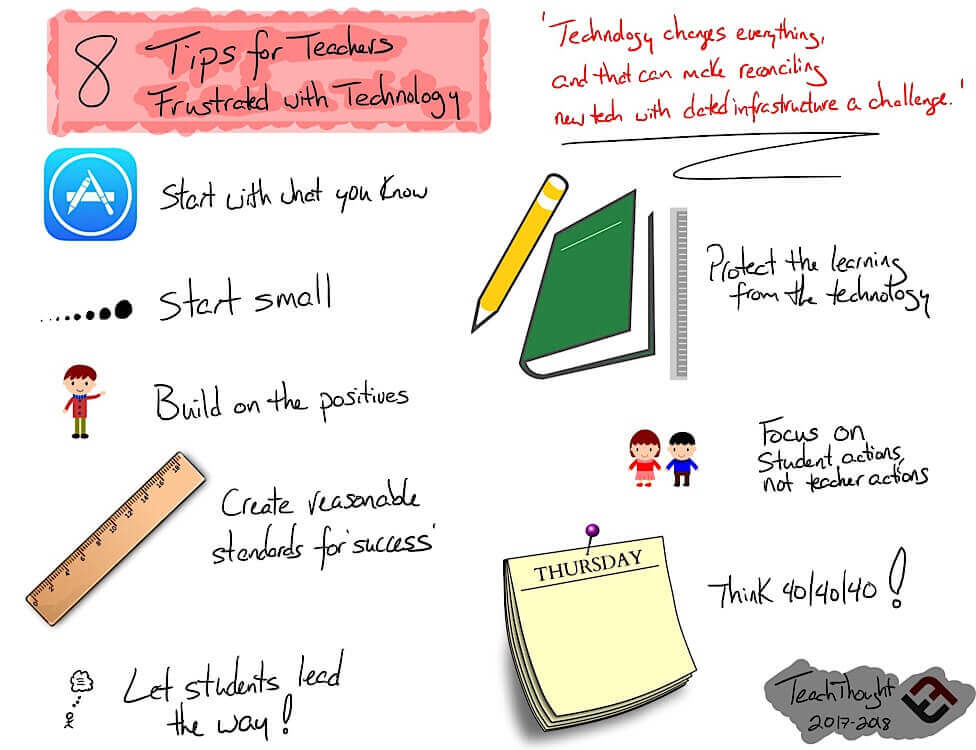
8 Beginner Tips For Teaching With Technology
by Terry Heick
I’m not crazy about writing this post, mainly because ‘integrating technology’ into teaching and learning is like adding electricity to architectural design.
Certainly a castle can be retrofitted for it, but ideally the architecture and the electricity are considered together, the electricity illuminating the architecture in flashing, reckless, blue arcs, the walls and ceilings of holding their ground in understanding. The ceiling of each room is built this way because there is electricity to provide central air. Windows are built here and here in this fashion because there are light bulbs instead of candles.
Electricity changes everything. Technology changes everything.
But there are also teachers in classrooms right now that don’t have the gift of design–that is, they can’t start fresh at audience and purpose: who am I teaching, and why? They are given content in the form of standards, and often given packaged standards in the form of curriculum. The assessment form is out of their hands, and even scheduling and pace with regard to scope-and-sequences and related maps.
For these teachers–maybe it’s you?–the ideal is supplanted by reality. You’re told to “use technology,” but nothing seems built for it. And when you do, what goes well is usually drowned out by the commotion of it all to the point that you’re not sure what actual learning is taking place. That’s frustrating.
Luckily, there are some things that can be done to mitigate that frustration.
8 Tips For Teachers Frustrated With Technology
1. Smart small.
One app. One activity. One project. Even just giving students a choice–a layered digital document or a handwritten essay, for example. No need to go all-out right away.
See also 25 Of The Best Apps To Promote Creativity In Students
2. Start with what you know.
So when seeking to start small, look to what you already know. Maybe it’s digital music. Digital photography. Video editing. Blogging. Social media. Live streaming. Reading apps. Video games. Film. Drones. Virtual reality. Google Earth.
There’s got to be something you know well enough to grab a handle and twist around a bit to learn more.
3. Build on the positives.
And when you do so, look for small victories. Everyone was able to sign-in! 2/3 of the students didn’t come close to producing anything close to what you thought they could, but six created anything better than you’ve ever seen from them, Look for small victories, and build on them.
4. Create reasonable standards for success.
If you do the above, you’re basically creating standards for success that are reasonable for your students in your classroom with you at the helm. Don’t hold yourself to any other standard other than adopting a mindset to try new things, and improving with them every day.
5. Let the students lead the way!
A huge help to teach students is the students themselves. Technology often decenters the teacher in the learning process, which can freak you out at first if you’re not seeing the big picture: One of the hopes of any teacher should be that they, over time, need you less and less.
6. Protect the learning from the technology.
Sometimes things will go wrong. Or every day they will. (Remember, things go haywire without technology too; these failures are just often less visible.)
Do your best when planing activities, lessons, units, and projects to protect the learning from the technology. Put another way, the technology can amplify the learning but you should be able to hear the learning without it. Plan a lesson so that if the tech fails, the learning, as much as possible, remains.
7. Focus on student actions, not teacher actions.
This one is simple enough. It’s not about you and what you do. What are they doing, and why? How can you help them develop their own standards for quality, so that they are their own harshest and most (lovingly) consistent critics?
8. Think 40/40/40.
Read more about the 40/40/40 rule here, but in short the idea is that if you are thinking big picture–especially if you are able to plan backwards from that big picture–the frustrations in the short-term are less distracting, less meaningful, and ultimately–well, ultimately less frustrating.
Conclusion
Though it can be a challenge at times, in the end remember that just as with all things in regards to your profession, it’s not about you. Teaching is one of the most selfless things you can do, requiring constant compromise, sacrifice, recalibration, and flexibility. This means that your ‘needs’ will often, by design, not be met so that you may meet the needs of others.
When the technology policy in your school doesn’t seem like it’s headed in the right direction, or when you don’t understand the function of an app or the reasoning for a large purchase by the district or how a certain app that everyone loves is any better than the textbook you’ve used for years, don’t take it personally. It’s sobering but imminently useful to remember that though you may indeed be correct on any or all of the above, you’re (presumably) paid to execute the functions of a teacher as outlined by local school and district policy.
This doesn’t excuse you from responding to your own pedagogical instincts as to what’s working, what students need, and how you can design and revise designs to meet those needs. That’s still, on the most macro level, what you’re (presumably) paid to do.
But on a micro-level, the things you do and are asked to do to make that happen aren’t always so clear. For all of our perceived inventiveness and sense of progress, technology (as we most commonly consider the word) is extremely new, immature, and unpredictable. More crucially, it is being shoe-horned into systems of learning that aren’t designed to accommodate it. That means it’s not always going to do what it’s supposed to do or sound like it’s supposed to sound or produce what it’s supposed to produce.
With regard to technology, education has to be in this for the long haul regardless of short-term loss as everything seeks to reconcile itself with everything else, much in the same way that the purpose of education is long-term–it should seek to improve the arc of students’ lives and the condition of their communities.
How much work it takes to make that happen is only one part of the timeless struggle of raising human beings.
